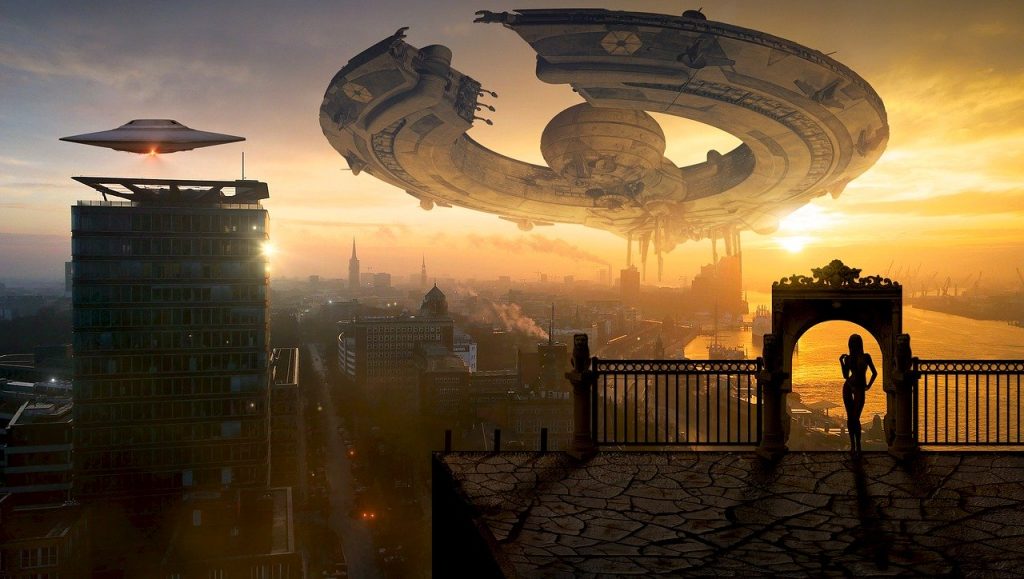Science fiction is an incredibly popular film genre that uses fictional science-based depictions like extra-terrestrial lifeforms, alien worlds, time-travel and other futuristic elements like spaceships and robots as their primary focus. These films often take some kind of political or social issue like the human condition to tell their story. Sci-fi aims to combine the real world with the supernatural to any questions of the unknown in science.
For a long time, the genre was not taken seriously by all, but since the 60s sci-fi films have pulled in large audiences and these films have become a regular staple of the film industry thanks to the advances in special effect technology.

Silent Film Sci-Fi
Sci-fi films came very early on in the silent film era. The first science fiction film is considered to be Le Voyage dans la Lune by Georges Méliès. This 1902 film drew on the description of a spacecraft being launched into the moon from a cannon, inspired by H. G. Wells. It pioneered the way for sci-fi films and became very popular after its release.
Popular sci-fi literature was adapted into early films, including Mary Shelley’s Frankenstein (1910) and Robert Louis Stevenson’s Dr Jekyll and Mr Hyde (1913). These two films demonstrated an overlap between sci-fi and horror, which is something we see a lot of in the sci-fi genre. In the 1920s there was much success with The Lost World (1925), one of the earliest forms on stop-motion animation, and the film that introduced many now-famous science fiction concepts like monsters, dinosaurs and hidden worlds.
Monster Films
Monster films are a sub-genre of science fiction that typically focus on a group of people struggling to survive attacks by one or more monsters, usually abnormally large ones. Science fiction has a tradition of films featuring monster attacks, and they typically also fall into the horror genre. The monster’s existence usually relies on scientific (or pseudo-scientific) rationale rather than for supernatural or magical reasons.
The reasoning for the monster creation can be a scientific experiment gone wrong, a nuclear accident or they have arrived from outer space and been released from their prison where they were being held. The monster is usually the villain, and the film will often focus on the human’s attempts to destroy it. Films in this genre include the King Kong films, the Godzilla films, Cloverfield (2008), Pacific Rim (2013) and Prometheus (2012).
Alien Films
The concept of intelligent life having extra-terrestrial origin is a popular staple in science fiction films. Early films of this kind often used alien life forms as a threat to the human race, and the invaders would often play a fictional representation of actual military or political threats on Earth, as shown in Mars Attacks! (1996), the Alien series, the Predator series, and The Chronicles of Riddick series.
However, some aliens are depicted as benign or even beneficial in some films like E. T. the Extra-Terrestrial (1982), Close Encounters of the Third Kind (1977), The Fifth Element (1997), Avatar (2009) and the Men in Black series.
Robots
Robots have been a staple in science fiction films for a long time. Humans often played them in metal suits in early films, such as The Phantom Empire (1935) and Metropolis (1927). But as technology advanced, films featuring robots were able to portray more sophisticated depictions of robots, the first film that did so being The Day the Earth Stood Still (1951).
Robots have played a wide range of roles in sci-fi films including supporting characters in films like Forbidden Planet (1956); side-kick characters like in films like Star Wars and Iron Man (2008), as well as villains in Logan’s Run (1976), 2001: A Space Odyssey (1968) and Eagle Eye (2008). In some cases, robots have even played leading characters in science fiction films, like Blade Runner (1982), WALL-E (2008) and Big Hero 6 (2014).
A trope of films based around robots includes robots becoming sentient and developing emotions and becoming self-aware, such as in A. I. Artificial Intelligence (2001) and Ex Machina (2014). Other films ask the question of whether robots will replace humans: I, Robot (2004), Reel Steel (2011). As technology develops, the depictions of robots in sci-fi films become more and more realistic, and some sci-fi dreams of robotics in days gone past have already been realised.
Time Travel
The concept of travelling backwards or forwards in time has always been a popular feature in sci-fi films. There have been plenty of commercially successful films that revolve around this idea, such as the Back to the Future series, Bill & Ted’s Excellent Adventure (1989) and the Terminator series. Other films utilise time travel, not from a machine, but as a source of inner or personal power, such as The Butterfly Effect (2004) and X-Men: Days of Future Past (2014).
Time travel films often play around with the idea of creating alternative futures by altering the past, creating alternative timelines and dimensions, time loops and time paradoxes. Films that allow the past to be altered will often explore the unintended consequences of this time travel.
